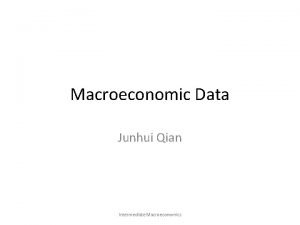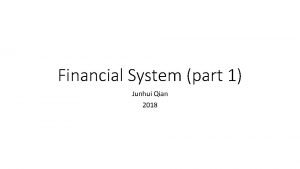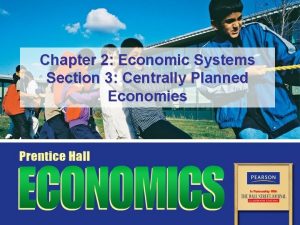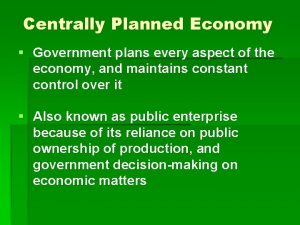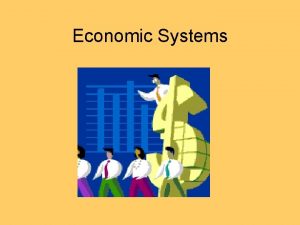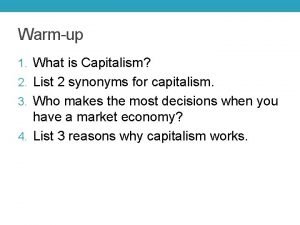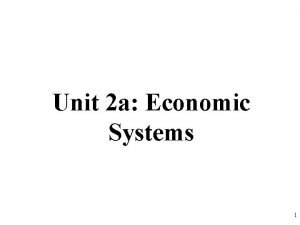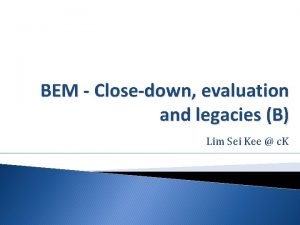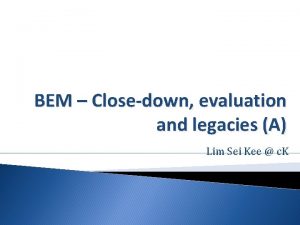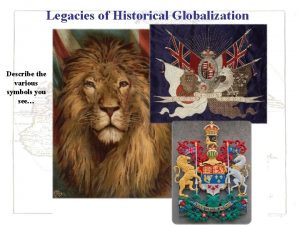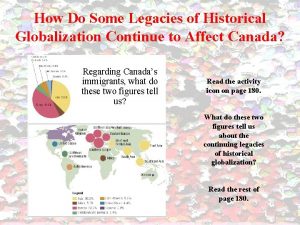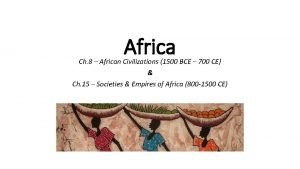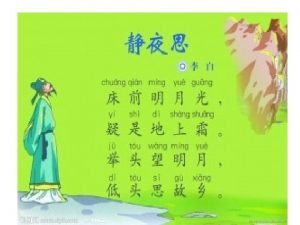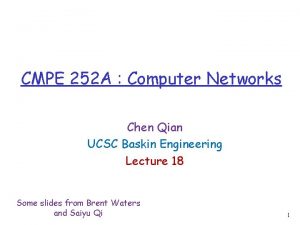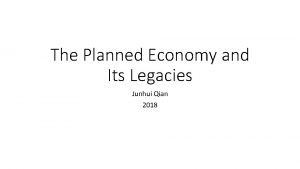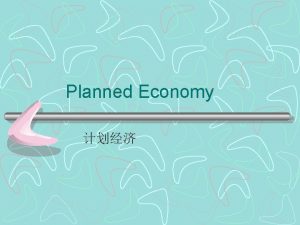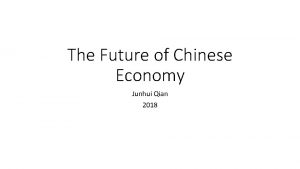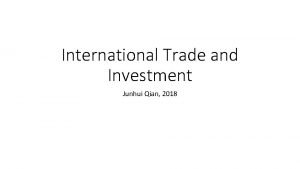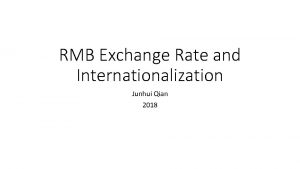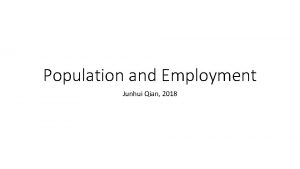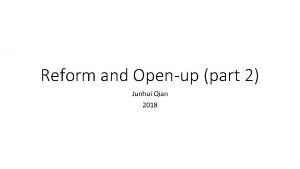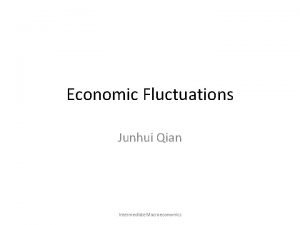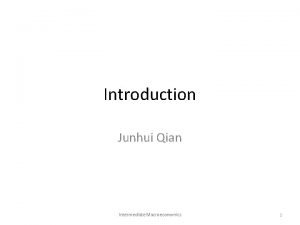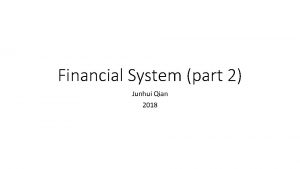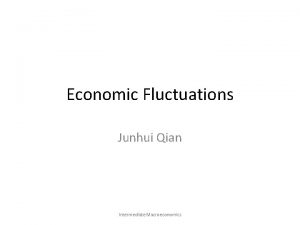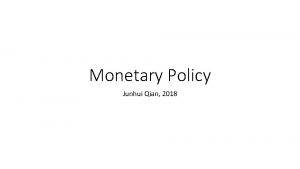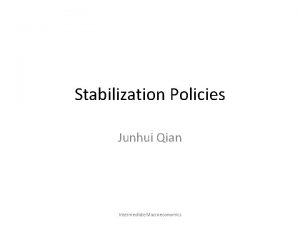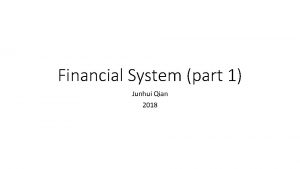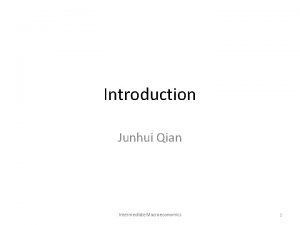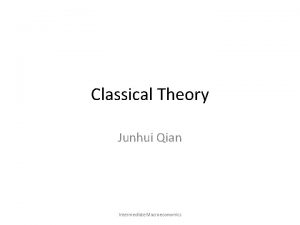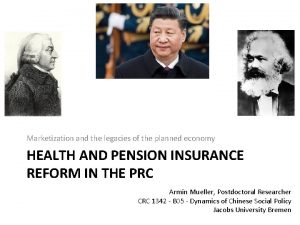The Planned Economy and Its Legacies Junhui Qian

























- Slides: 25

The Planned Economy and Its Legacies Junhui Qian 2018

Outline • Why China adopted economic planning • How the planned economy worked (failed) • Policy instability

Remember a few names… Zhou Enlai, 1955, in Bandung of Indonesia. Mao Zedong, in cultural revolution Deng Xiaoping (left) and Liu Shaoqi (right) Zhou Enlai, the Premier, 1976

Why China Adopted Economic Planning • After the foundation of PRC, China followed the Marxism-Leninism ideology that calls for centralized planning of the economy. • Planned economy (or command economy) was generally considered feasible, and even superior. • The Soviet Union’s planned economy was apparently successful. • Paul Samuelson: “Contrary to what many skeptics had earlier believed, the Soviet economy is proof that. . . a socialist, command economy can function and even thrive. ” • There was a national priority to develop the heavy industry, despite limited funding. • The Chinese leaders wanted to speedily transform its weak agrarian economy into a powerful industrial economy.

The Curse of Heavy Industry • Development of heavy industries in an agrarian economy goes against the market force • Labor was cheap and capital expensive. • Requires huge amount of initial capital expenditure and takes a long time before generating returns. • The state takes administrative measures to ensure substantial surplus for the heavy industry. • Suppress prices of inputs (wage) • Monopoly status (the private ownership of productive assets is abolished) • Low wage calls for low cost of living for industrial workers. • Low price of food necessitates low income of farmers. • Migration of farmers to the cities is forbidden (through the Hukou system).

How the Planned Economy Works • Every five year, the central government makes a five-year plan that outlines social and economic development initiatives to be accomplished in the next five years. • Local governments play important roles in the draft and implementation of the five-year plan. • Factory managers implement production plans, given the resources (worker and materials). • They do not make decision on what to produce, where to source, and whom to sell. All profits belong to the government, who allocates the profit according to the plan. • Consumers do not have a say in what to produce, either. They buy what are available on the market and what “coupon” they have. • Because the prices of the consumer goods are kept artificially low, ration is implemented for almost every goods, through “coupons” issued by the government.

Ration Coupons

The Birth of Grain Coupons • Among all coupons, the grain coupon was the most important. • Food rationing was not designed by the planer, but the product of necessity. • From 1950 to 1953, urban population increased dramatically (due to the large-scale industrial investment), putting stress on the grain supply. • To keep the grain price low for industrial workers, the central government established the “uniform-procurement uniform-sale” system (粮食统购统销制度) in 1953. • Compulsory procurement of grains from farmers. • Rationing of grains in the cities.

Regional Grain Self-sufficiency • Because the price of grain was kept artificially low, provinces with comparative advantages in farming are reluctant to “export” grain to other provinces. • The equilibrium of this game was regional grain self-sufficiency. • “The mayor is in charge of the vegetable basket, and the governor takes care of the rice sack. ” • This is but one example of fragmentation under economic planning. The cost is of course economic efficiency. • Economic planning was supposed to take advantages of the scale of economy. But the price distortion and the institutional responses make the economy fragmented, unable to realize the scale of economy.

Characteristics of Chinese Planned Economy • Similarity with the Soviet Union • Ownership • Command-based resource allocation • No role for price in resource allocation • Micro-management of factories • Chinese characteristics • More decentralized: local governments play important roles • Big-push industrialization with limited urbanization

Big-push Industrialization Ratio of Industrial Output to Agricultural Output (%) 450 400 350 300 250 200 150 100 50 0 1952 1954 1956 1958 1960 1962 1964 1966 1968 1970 1972 1974 1976 1978 1980 1982 1984 1986 1988 1990 1992 1994 1996 1998 2000 2002 2004 2006 2008 2010 2012 2014 2016

Big-Push Industrialization • Investment share was high. • Most (more than 80%) of investment went to heavy industry. • Industry’s share of GDP climbed from 18% in 1952 to 44% in 1978, while agricultural share declined from 51% to 28%. • Thanks to price distortions, the state-owned enterprises were relatively profitable, despite the inefficiency. • A modern tax system was not necessary, since the government could raise from the monopoly of farm and industrial goods more than 25% of GDP as budgetary revenues.


Limited Urbanization Proportion of Rural Employment in Total (%) 100 90 80 70 60 50 40 30 20 10 0 1952 1954 1956 1958 1960 1962 1964 1966 1968 1970 1972 1974 1976 1978 1980 1982 1984 1986 1988 1990 1992 1994 1996 1998 2000 2002 2004 2006 2008 2010 2012 2014 2016

Urban-Rural Dichotomy • Growth driven by the investment in heavy industries did not raise labor demand proportionally. Job opportunities were not enough for urban residents, let alone rural migrants. • Urban residents worked at the government or SOE’s and their income were much higher than farmers. • To maintain stability in the cities, a strict Hukou (户口) system was established to prevent migration from rural to urban. • Thus a urban-rural dichotomy was institutionalized.

Compare with Industrialization in Hong Kong and Taiwan • Industrialization was started from the light industries, producing consumer goods, often for export. Gradually heavier industries also developed as demand for machines increased and private savings accumulated. • Since light industries are generally labor-intensive, urbanization took place naturally as the economy grew. • Household income and private saving grew along with the economy.

GDP per cap (Mainland v. s. Taiwan, in USD) 3500 3000 2500 2000 1500 1000 500 0 1952 1953 1954 1955 1956 1957 1958 1959 1960 1961 1962 1963 1964 1965 1966 1967 1968 1969 1970 1971 1972 1973 1974 1975 1976 1977 1978 China 2 cgdp Taiwan cgdp

Assessing the Big-Push Industrialization • Misallocation of resources • Absence of incentives • In terms of aggregate output, China achieved at best mediocre growth. • In terms of welfare improvement for the average Chinese people, the achievement was even less applaudable. The living standard of Chinese people was even lower than the number suggests.

The Great Leap Forward “Steel Mills” in the countryside Grains from “harvests” were hauled away.

Great Famine (1959 -1961)

Causes of the Great Famine • Official explanation: bad weather. • Bad policies and bad management. • Free meals in the commune kitchen exhausted food stock. • Zealous cadres encouraged wrong practices like dense planting, in an effort to increase land productivity. Mao genuinely believed in the hyperbole of 10, 000 jin/mu (亩产万斤). • Reduced incentive for individuals in large communes. • Average size of a commune was 10, 000 farmers and 4, 000 hectares of land. • The communes were broken down to “production teams”, which contained 20 to 30 households. • Compulsory participation of cooperatives. • The article of “Free to join and free to exit” in the 1956 National People’s Congress articles of association disappeared in 1958 and did not come back until 1978. • The false reporting of harvests in the local and the true procurement of grains from the starving countryside.

Policy Instability • • • Economic recovery 1949 -1952 The twin-peaks of the first five-year plan 1953 and 1956 Retrenchment: The “Hundred Flowers” of 1956 -1957 The Great Leap Forward 1958 -1960 Retrenchment: Crisis and Readjustment 1961 -1963 Launch of the “Third Front” 1964 -1966 Retrenchment: The Cultural Revolution 1967 -1969 Preparation for war 1970 Retrenchment: Consolidation and drift 1972 -1976 The leap outward and the end of Maoism 1977 -1978 A final turning point: The Third Plenum of 11 th CCP Central Committee, Dec 1978


Cultural Revolution (1966 -1976)

Legacies of the First Three Decades of PRC • The economy stagnated at an extremely low level. • Almost everybody was a loser by the end of the Cultural Revolution. • On one hand, there was a deep willingness to experiment and reform. • On the other, political stability was treasured.
 Macroeconomics
Macroeconomics Junhui qian
Junhui qian Planned economy or planned destruction political cartoon
Planned economy or planned destruction political cartoon Centrally planned economy
Centrally planned economy Describe how a centrally planned economy is organized
Describe how a centrally planned economy is organized Centrally planned economy
Centrally planned economy What do economic systems seek to do?
What do economic systems seek to do? Traditional economy advantages
Traditional economy advantages Planned economy
Planned economy Athens and sparta were both
Athens and sparta were both The legacies of ancient greece
The legacies of ancient greece Bem legacies
Bem legacies Legacies bem
Legacies bem What was the legacy of the roman empire
What was the legacy of the roman empire Legacies of ancient greece
Legacies of ancient greece Legacies symbols
Legacies symbols Legacies of historical globalization
Legacies of historical globalization The legacy of ancient greece
The legacy of ancient greece What lasting legacies did the aksum kingdom leave
What lasting legacies did the aksum kingdom leave What is tourism multiplier and its effect on the economy
What is tourism multiplier and its effect on the economy Chuang qian ming yue guang li bai
Chuang qian ming yue guang li bai Ni lei
Ni lei Steve qian
Steve qian Qian chen ucsc
Qian chen ucsc Sheri tague purdue
Sheri tague purdue Polytomous
Polytomous
